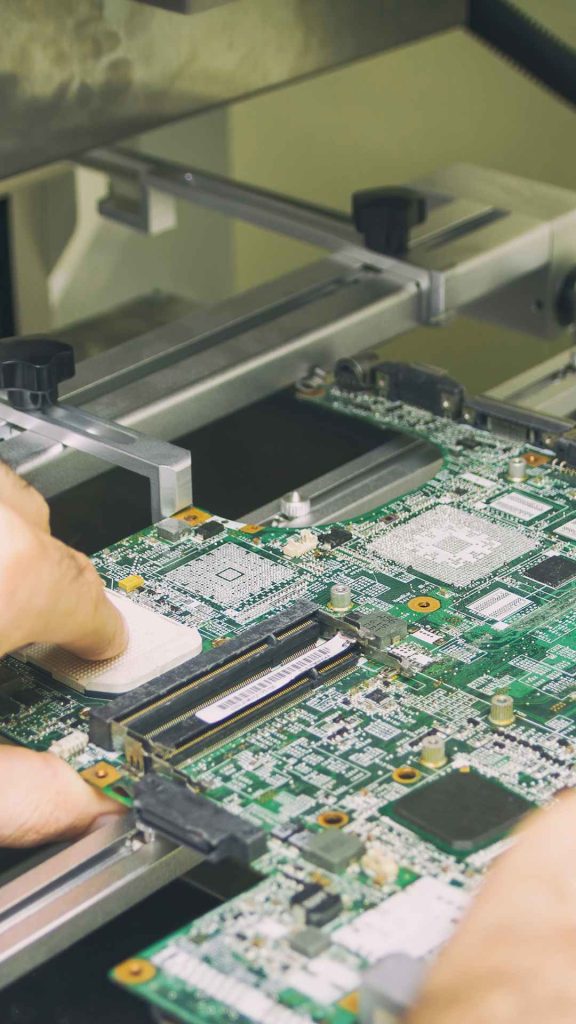In the landscape of modern electronics, Ball Grid Array (BGA) components are true marvels of engineering. These compact, high-performance packages enable the incredible density and functionality we see in today’s most advanced devices, from powerful servers and networking equipment to sophisticated medical and aerospace systems. By arranging hundreds, or even thousands, of solder connections in a grid array on the underside of the chip, BGAs offer superior electrical and thermal performance in a minimal footprint. However, their greatest strength is also their greatest challenge: all of these critical connections are hidden from view, making inspection and repair incredibly complex. When a BGA component fails or a connection is flawed, you can’t simply touch it up with a soldering iron. This is where the highly specialized process of BGA rework comes into play. It is less a simple repair and more a form of microscopic surgery for electronics – a delicate art that blends advanced technology with profound technician skill. As a dedicated American manufacturer, BENCOR understands that mastering these complex challenges is essential to providing true end-to-end support for high-value electronic assemblies.
Why is BGA Rework Necessary? Common Causes for Failure
In a perfect world, every component would be placed flawlessly and function indefinitely. In reality, even with the most advanced manufacturing processes, issues can arise that necessitate rework. BGA rework is a critical capability for addressing several common scenarios, saving valuable, complex boards from being scrapped.
Manufacturing Defects
Despite rigorous process control, subtle defects can occur during the initial SMT assembly process. Automated X-Ray Inspection (AXI) might reveal issues like solder bridging (shorts) between adjacent solder balls under the BGA, significant voids (air pockets) within the solder joints that can compromise long-term reliability, or “head-in-pillow” defects, where the solder paste on the board and the solder ball on the component fail to fully coalesce into a single, robust joint. These issues must be corrected to ensure the product’s integrity.
Component Failure
Sometimes, the integrated circuit (IC) within the BGA package itself may fail during initial functional testing or later in its operational life. In these cases, the entire multi-layer PCB, which can be extremely expensive, is still perfectly good. BGA rework allows for the precise removal of the single faulty chip and its replacement with a new one, saving immense cost and resources.
Prototyping and Upgrades
During the product development cycle, engineers often need to iterate. A prototype board might require a specific BGA to be replaced with a newer revision or an upgraded version with different features. BGA rework capability is essential for making these engineering changes possible without having to fabricate entirely new prototype boards for every iteration.
Field Returns and High-Value Repair
For high-value electronic equipment used in industries like telecommunications, medicine, or aerospace, product longevity and serviceability are key. When a device fails in the field due to a BGA-related issue, it is far more cost-effective to perform a depot-level repair by reworking the BGA than it is to replace the entire system.

The BGA Rework Process: A Multi-Stage Precision Operation
BGA rework is a systematic and highly controlled process that demands specialized equipment and deep expertise. Each step is critical to the success of the operation.
Before any heat is applied, the PCB assembly must be properly prepared. Most boards are "baked" in a controlled oven at a low temperature for several hours. This critical step removes any trapped moisture from within the PCB's layers. Skipping this can cause the trapped moisture to turn to steam during the heating process, leading to a destructive effect known as "popcorning," where the layers of the board delaminate. Concurrently, a precise thermal profile is created. This is a recipe that dictates the exact temperatures and ramp rates for heating the board, ensuring the BGA's solder melts without overheating and damaging the board or nearby sensitive components.
The BGA is removed using a specialized BGA rework station. This machine uses a combination of top-side hot air or infrared (IR) heaters focused on the BGA and bottom-side heaters to warm the entire board evenly, preventing thermal shock and warpage. The station executes the carefully developed thermal profile. Once the solder balls reach their molten (liquidus) state, a vacuum-powered pickup tool on the station gently lifts the BGA component straight off the PCB pads.
After the component is removed, the pads on the PCB are left with residual solder. This site must be meticulously cleaned and prepared for the new component. This is a highly skilled manual step where a technician uses a specialized soldering iron tip and solder wick to gently remove the old solder, leaving the pads perfectly clean, flat, and ready for a new connection. Great care must be taken not to damage the delicate solder mask around the pads or lift the pads themselves from the board. The site is then thoroughly cleaned and inspected under magnification.
There are two paths at this stage. If a brand-new BGA is being installed, it will arrive from the manufacturer with fresh solder balls already attached. In this case, a precise amount of solder paste may be printed onto the prepared PCB pads using a miniature, site-specific stencil.
The new or reballed BGA must be placed onto the prepared site with extreme precision. The BGA rework station uses a sophisticated split-vision optical system that allows the operator to simultaneously view the solder balls on the bottom of the component and the pads on the top of the PCB. The system enables the operator to align the two patterns perfectly. Once aligned, the component is placed, and the rework station executes the reflow thermal profile a second time, melting the solder to form hundreds of new, perfect connections.
The work is not complete until it is verified. Since the newly formed solder joints are hidden beneath the component, visual inspection is impossible. **Automated X-Ray Inspection (AXI) is mandatory.** AXI allows technicians to see through the component and inspect the quality of each solder joint, verifying proper shape, checking for shorts or opens, and ensuring the component is correctly aligned. This final verification step is the only way to have complete confidence in the quality and long-term reliability of the rework.
The Critical Challenges of BGA Rework
The complexity of BGA rework presents several key challenges that highlight the need for expertise and the right equipment:
- Precise Thermal Management: The primary challenge is applying enough focused heat to melt the high-temperature lead-free solder of the BGA without damaging the PCB substrate or the surrounding heat-sensitive components.
- Moisture Sensitivity: As mentioned, moisture is the enemy. Proper pre-baking and handling of Moisture Sensitive Devices (MSDs) are non-negotiable to prevent board damage.
- Operator Skill and Experience: The manual steps of site preparation and reballing are highly dependent on the steady hand and deep experience of the technician. This is a craft honed over years, not something that can be learned from a manual alone.
- Equipment Capability: Success is impossible without a high-quality, calibrated BGA rework station for precise thermal control and alignment, and a high-resolution AXI machine for essential final verification.

The BENCOR Approach: Expertise and Precision in Complex Rework
At BENCOR, we understand that manufacturing modern electronics means being prepared to handle every level of complexity. While high-yield initial assembly is always the goal, having the capability and deep understanding of advanced rework processes is a critical part of providing a complete manufacturing solution. We possess the process knowledge and have cultivated the expertise required to manage these intricate tasks effectively, ensuring that our customers’ valuable assets are handled with the utmost care.
This level of highly skilled, technical work is a testament to the depth of expertise found within the American manufacturing sector. It represents a commitment to problem-solving and technical mastery, ensuring that high-value electronic products can be supported, repaired, and serviced right here in the USA. Our understanding of the entire process, from creating precise thermal profiles to the absolute necessity of post-rework X-ray verification, gives our customers confidence. It reduces their risk, minimizes costly board scrap, and demonstrates a partnership that extends beyond simple assembly to encompass the full lifecycle of their product.
Conclusion: BGA rework is far more than a simple repair; it is a sophisticated discipline that blends the science of thermal dynamics with the art of skilled craftsmanship. It is an essential capability in today’s electronics industry, enabling the repair, upgrade, and salvage of complex and expensive PCB assemblies that would otherwise be lost. Success requires a meticulous, multi-stage process, specialized equipment, and, most importantly, highly experienced technicians. As your dedicated American manufacturing partner, BENCOR understands these complexities. We are committed to delivering unwavering quality, whether in the initial high-volume assembly or in the expert handling of the most advanced rework challenges, ensuring the maximum value and reliability of your electronic products throughout their entire lifecycle.




